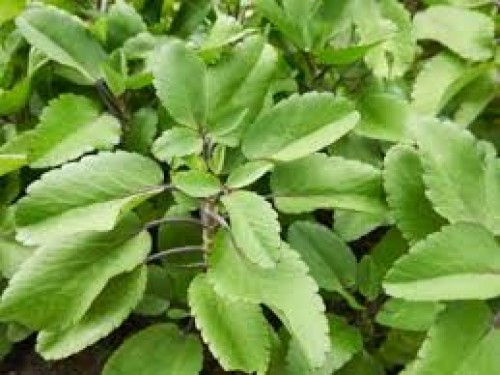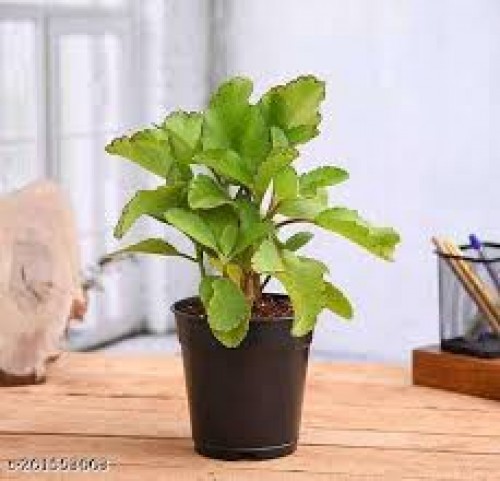off
-
Sold
-

-

out
Patharchatta Plant: Nature, Care & Advantages
Patharchatta (Botanical name: Bryophyllum pinnatum) is a succulent plant known for its remarkable ability to propagate from leaves and stem cuttings. It is commonly referred to as "Mother of Thousands" or "Leaf of Life" due to its tendency to produce small plantlets along its leaf edges. This plant is often used in traditional medicine and is highly valued for its therapeutic properties, making it a popular choice in herbal remedies.
Nature of the Patharchatta Plant
Patharchatta is a perennial succulent that can grow up to 1 meter in height. It has thick, fleshy, green leaves with reddish-purple spots and produces small, bell-shaped pink or yellow flowers. This plant is native to tropical and subtropical regions of Africa, Asia, and the Pacific Islands, but it has become widely distributed across the globe due to its hardiness and easy propagation methods. Patharchatta prefers warm climates and is well-suited to growing in pots or in the ground, making it an ideal plant for both indoor and outdoor gardening.
Care for the Patharchatta Plant
- Climate: Patharchatta thrives in warm climates and is tolerant of a wide range of temperatures, though it prefers temperatures between 20°C to 35°C (68°F to 95°F). It can withstand short periods of cold, but prolonged exposure to low temperatures may damage the plant.
- Soil: This plant prefers well-draining, sandy or loamy soil. A slightly acidic to neutral pH (6.0 to 7.5) is ideal. If planting in pots, ensure that the container has drainage holes to prevent waterlogging.
- Watering: Patharchatta is drought-tolerant and does not require frequent watering. Allow the soil to dry out completely between waterings. Overwatering can cause root rot, so it's important to ensure the plant is not sitting in water. Water deeply but infrequently, especially during the growing season.
- Sunlight: Patharchatta requires full sunlight to grow well. It should be placed in a location that receives at least 6 hours of direct sunlight each day. In shadier conditions, the plant may become leggy and produce fewer leaves.
- Fertilization: Patharchatta does not need heavy fertilization. A light application of a balanced fertilizer once a month during the growing season is sufficient. Avoid over-fertilizing, as this can cause the plant to become too leggy.
- Propagation: Patharchatta is easy to propagate from leaf or stem cuttings. Simply cut a healthy leaf or stem, allow it to dry for a few days, and then place it in well-draining soil or water. Roots will form, and new plants will begin to grow from the leaf or stem.
- Pruning: Regular pruning is not required, but removing dead or damaged leaves will help maintain the plant's health and appearance. This also prevents the spread of disease.
Advantages of the Patharchatta Plant
- Medicinal Properties: Patharchatta has a long history of use in traditional medicine. It is commonly used to treat a variety of ailments, including kidney stones, urinary tract infections, and respiratory conditions like asthma and bronchitis. The plant has anti-inflammatory, antioxidant, and antimicrobial properties that contribute to its therapeutic benefits.
- Promotes Kidney Health: One of the most well-known uses of Patharchatta is for kidney health. It is believed to help in the prevention and treatment of kidney stones by flushing out toxins and promoting the healthy functioning of the kidneys.
- Wound Healing: Patharchatta leaves are used in herbal remedies for their wound-healing properties. Applying crushed leaves to cuts, burns, and insect bites can accelerate the healing process and reduce inflammation.
- Anti-inflammatory Benefits: Patharchatta is often used in traditional medicine to treat conditions involving inflammation, such as arthritis. Its anti-inflammatory compounds can help reduce pain and swelling in the joints.
- Boosts Immune System: The plant contains compounds that have immune-boosting properties. Regular consumption or topical use of Patharchatta can help strengthen the immune system, improving the body's ability to fight off infections.
- Easy to Grow: Patharchatta is a low-maintenance plant that is easy to grow and propagate. Its drought tolerance and ability to thrive in a variety of conditions make it an ideal plant for both beginner and experienced gardeners.
- Aesthetic Value: Apart from its medicinal uses, Patharchatta also adds aesthetic value to gardens. Its unique appearance, with its fleshy green leaves and small flowers, makes it an attractive plant to grow indoors or outdoors.
Conclusion
Patharchatta is a versatile and hardy plant that offers both aesthetic and medicinal benefits. With its easy care requirements and numerous health advantages, it is a valuable addition to any garden or home. Whether used in traditional remedies or simply admired for its beauty, Patharchatta remains a popular and beneficial plant around the world.